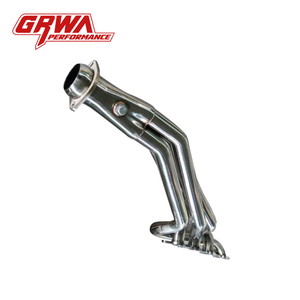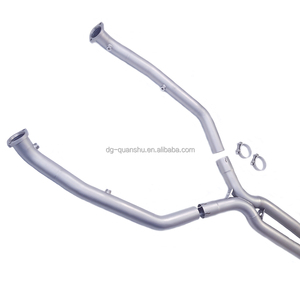(145 products available)








































































 Ready to Ship
Ready to Ship






































































































Rsx headers are available in various types, which include:
Stainless Steel Headers
Stainless steel headers are popular among car enthusiasts because of their strength and resistance to corrosion. They are less likely to rust or deteriorate from exposure to high exhaust temperatures and moisture. They also improve the durability and performance of the vehicle's exhaust system. Stainless steel headers come in different alloys, which include 409, 304, and 321. Each alloy has distinct characteristics suitable for different applications. The 304 alloy is more resistant to corrosion, while the 321 alloy is known for its strength at high temperatures.
Cast Iron Headers
Cast iron headers have traditionally been used in many vehicles. They are known for their durability and ability to withstand high temperatures and pressures. Cast iron is a suitable material for exhaust headers because of its strength and toughness. It is less likely to crack or warp, which ensures the headers have a long lifespan. Additionally, cast iron headers are effective at dampening engine noise.
Ceramic Coated Headers
Ceramic-coated headers are exhaust headers that have a ceramic coating applied to their surface. This coating offers several advantages, including improved heat resistance, reduced heat transfer to the engine bay, and enhanced appearance. The ceramic coating on the headers can withstand high temperatures and protect the underlying material from corrosion. Additionally, ceramic-coated headers can improve the performance and efficiency of a vehicle by increasing exhaust flow and reducing heat-related issues.
Titanium Headers
Titanium headers are known for being lightweight and highly resistant to corrosion. This makes them suitable for applications where weight reduction is essential, such as in racing or high-performance vehicles. The titanium material can withstand high temperatures, making these headers effective at improving exhaust flow and overall engine performance. Additionally, the attractive metallic finish of titanium headers can enhance the visual appeal of a vehicle's engine bay.
Long Tube Headers
Long tube headers are designed with long primary pipes that extend further into the exhaust system. This design maximizes exhaust flow and improves engine performance. The longer pipe length enhances low-end torque and increases high-end horsepower. Long tube headers are particularly beneficial for racing and performance-oriented vehicles. However, their extended length may pose challenges during installation or fitment in some engine bays.
Shorty Headers
Shorty headers are a type of exhaust header that is designed with shorter primary pipes. Compared to long tube headers, shorty headers have a more compact design that results in limited exhaust scavenging effects. Shorty headers are easier to install, making them a practical choice for many vehicles. They can also improve throttle response and overall engine performance, especially in midrange RPM.
Material
The headers are made of different materials. Each of these materials will have its own maintenance requirements. For instance, stainless steel headers will need to be cleaned regularly to prevent rusting.
Coating
The rsx headers can be coated with different materials. Some of these coatings include chrome and ceramic. Each of these coatings will have its own maintenance requirements. For instance, chrome headers should be cleaned with a soft cloth and a mild cleaner. Abrasive materials can scratch the surface.
Size and Dimension
The size of the RSX headers varies depending on the model and make. The headers come in different lengths, widths, and diameters. The size of the headers affects their performance. Larger and wider headers reduce back pressure and increase exhaust flow.
Design
Different headers have different pipe designs. Some of the common pipe designs include 4-1 and 4-2-1. The 4-1 pipes merge at one point, while the 4-2-1 pipes merge at two points. The rsx headers also have different flange designs.
Flange Thickness
The rsx headers have different flange thicknesses. A thicker flange improves the seal between the header and the exhaust system. It also reduces the chances of warping. The normal header flange thickness ranges from 1/4 to 1/2 inch (6 to 12 mm).
Port Shape and Size
The rsx header ports are shaped and sized to match the engine's cylinder head. The port shape and size affect the exhaust flow. The ports are usually rectangular or oval. The port size ranges from 1.5 to 2 inches (38 to 51 mm) in diameter.
Connection Type
The rsx headers are connected to the exhaust system using different connection types. Some of the common connection types include v-band, slip joint, and flange bolted connections. The connection type affects the ease of installation and disassembly.
To keep the rsx headers in good condition, they need to be maintained. Below are some of the maintenance tips.
Choosing the right RSX header can be a daunting task with headers available in various materials, designs, and specifications. Here are some practical tips that make selecting the ideal RSX headers easier.
Consider the Engine's Performance Requirements
The first step in choosing the right RSX header is considering the performance requirements. What does the header intended to achieve? Is it better torque, better horsepower, or an overall balanced performance? Understanding the performance requirement helps in selecting a header that meets the needs.
Understand the Different Header Designs
RSX headers come in various designs, each with its benefits. The most common types of headers are long tube headers and shorty headers. Long tube headers are ideal for high-performance vehicles. They provide better horsepower by improving exhaust flow. On the other hand, shorty headers are suitable for daily driving vehicles. They offer a slight increase in torque.
Check the Material
RSX headers are made from different materials. The most common ones are stainless steel and mild steel. Stainless steel headers are great for high-performance gains. They are durable and can withstand high temperatures. Mild steel headers are affordable but prone to rusting.
Consider the Budget
Another important consideration when choosing the right RSX headers is the budget. RSX headers are available at different prices, depending on the brand, material, and design. Setting a budget and sticking to it is essential. Avoid the temptation of overspending. Remember, there are high-performance headers at affordable prices.
Consider Ease of Installation
When choosing the right RSX headers, consider the ease of installation. Some headers are easy to install, while others require professional installation. If looking to install the header as a DIY project, it is advisable to choose a header that is easy to install.
Compatibility
Before choosing the right RSX headers, it is important to consider compatibility. Not all headers are compatible with every vehicle model. Ensure the header chosen is compatible with the vehicle model and engine specifications.
Brand Reputation
Brand reputation is another important consideration when choosing the right RSX headers. Go for headers made by reputable manufacturers. This ensures quality and durability. Reading online reviews from other customers can also help in selecting a reputable header.
Before replacing a header, it is good to have some mechanical knowledge. Below are some easy-to-follow steps on how to replace RSX header.
First, it is important to have all the necessary tools. These include:
Before starting the process, make sure the car is parked on a flat surface and the engine is cooled down. Also, disconnect the negative battery cable.
To replace the RSX header, follow the steps below:
These steps are simple and easy to follow. However, make sure to follow the manufacturer's instructions when replacing the RSX header.
Q1: Do RSX headers fit on other vehicles?
A1: While RSX headers are designed for the Acura RSX, they may also fit other vehicles with similar engine specifications. This includes some models of the Honda Civic and Honda Accord. However, it is important to verify compatibility based on the specific engine code and exhaust flange design.
Q2: What are the benefits of installing a 3-inch RSX headers?
A2: A 3-inch RSX headers can provide a larger diameter piping for improved exhaust flow. This allows for better performance gains, especially on turbocharged or high-boost applications. The increased size can accommodate greater exhaust volume and reduce back pressure further. However, proper tuning and supporting modifications are necessary to fully utilize the benefits of 3-inch headers.
Q3: Are RSX headers legal?
A3: The legality of RSX headers depends on several factors, including the type of headers, the materials used, and local emissions regulations. Headers that include a catalytic converter are generally legal if they meet emissions standards. However, header-only modifications without a cat may be illegal in some areas due to increased hydrocarbon emissions. It is important to check local laws and regulations regarding aftermarket exhaust components.
Q4: How can I ensure that the headers I purchase will fit my Acura RSX?
A4: To ensure proper fitment, buyers should select headers specifically designed for their make, model, and year of the Acura RSX. Additionally, buyers can verify compatibility by checking the engine code, exhaust flange shape, and O2 sensor locations against the header specifications. Consulting with a professional mechanic or performance shop can also provide guidance in selecting the right headers for optimal fitment and performance.